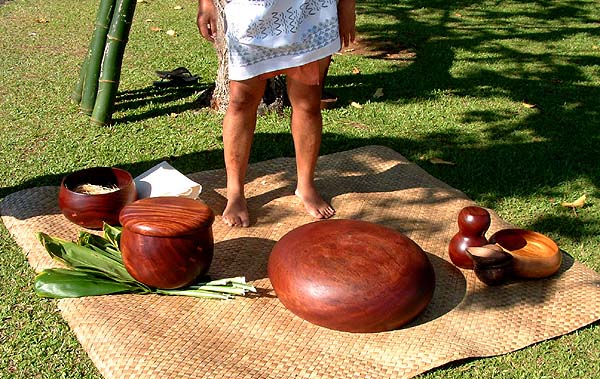| Pu‘u Kohola Annual Ceremony:
|
| "We meet in August, usually around the 17th," Mel explains, "and usually everybody tries to get there for that Thursday night’s meeting, where you bring in new people and everybody meets each other. Everybody listens to what will happen over the next three days. And usually you want to get there Thursday night, because that’s for you. And because the next morning, you’re going to get up at 4 o’clock, at the sounding of the shells. Some participants get up way before that. Everybody is dressed to go be under the heiau before the sunrise."
|
||
|
|
||
"Friday morning, we hold a ceremony that I would really encourage everybody to attend one time in their lives. Because it happens before sunrise, and you see the people coming in from all directions in the dark, some holding torches. And it’s an experience you cannot find anyplace in Hawai‘i. For that morning, that cultural experience, you can only get em over here, and it’s going to stay for the rest of your life. Because it’s you, it’s us, it’s our culture, it’s our ancestors. "The men go up on top of Pu‘u Kohola heiau. Papa Kanaka designated Mailekini a ladies’ heiau, whereby they can have their own ceremonies, just like ours. Down there they go through the same ritual we go through."
|
|
|
"That ritual happens on Friday morning. We go on both heiau, and we have ceremonies for those who have passed. And there is a ritual also for cleansing with the salt water from the ocean. And there is the time for talking about what happened, and there’s a time for talk about what’s going to happen, what we feel should happen in the future. It’s a meeting time for anybody. And if you’re honoring somebody, that meeting is the time for it. "Then when the meeting is pau on Friday, we usually adjourn and go back to the Park headquarters above the heiau, where we have breakfast. After breakfast, then we have workshops. And the workshops are related for planting, for weaving, lua [martial arts] practice. There are different types of workshops at different times. When they are through, then it’s a rest period."
|
|
|
|
|
"We come back in the afternoon, and there is an ‘awa ceremony for those that are going make a commitment. It’s like a membership type of ceremony. For people who come in new, who want to be part of the group, we have this ceremony. You can commit to Pu‘u Kohola. In that way, by coming here and getting involved, you help to stimulate the spirit of Pu’u Kohola, to keep Pu’u Kohola moving and alive. Culturally, that is our calling, that’s our mission: to keep Pu’u Kohola not as a dead place, but as a living place."
|
||
|
|
||
"Saturday morning is when we have a full-on dress ceremony. Usually that starts about 7:30. We would go in early because Kawaihae is hot in the afternoon So we’ve been starting early and getting through early before the heat comes in. "It’s a high-level ceremony whereby all the chiefs are dressed in long capes and mahiole [feather helmets]. And you have the lesser chiefs with the short capes, and the ali‘i koa [warrior chiefs], and the na koa [warriors], right down the line. And of course we have our chanters. We have the advisors. It’s a whole body of people involved in Pu‘u Kohola, to keep the place alive."
|
|
|
"At that time, we would process from behind the heiau. Everybody flanks the heiau, touches the heiau, then we pule [pray], so everybody gets a feel of that heiau at that prayer. And usually the kahuna is doing the praying and thanking God, the sun, the elements, everything, to bless the day. And after that, we walk down from behind the heiau.We come down and take seats. "Then we have a ho‘okupu ceremony, whereby all the islands will bring their ho‘okupu and chant. Various groups or halau bring in ho‘okupu [offerings]. That’s the first part of ceremony. And after that, some of the island warriors come in, and their ho‘okupu is a sham battle some times, or a lua demonstration on fighting, but usually we have something really exciting. When we finish that, the ceremony is ended through the head chanter asking the ali‘i-‘ai-moku, ‘is that all?,’ then he says ‘that’s all, that’s all, that’s pau.’ And we go back up and around the back of the heiau."
|
|
|
|
|
"Saturday late afternoon, we have another ‘awa ceremony. Then the night’s programs close up the activities for that year. Those performances are the highlight of that night’s activities. Just letting down one’s hair, and participating in that. "And we have good food. Fresh fish and usually it’s served in the old way. They like to keep it close to the way they ate in those days. We have the poi, we have fish from the ocean, and taro, poi, potato. At times we get lu‘au leaves, and haupia. "This ceremony closes the festivities."
|
||
|
|
||
|
|||||
|
|||||







